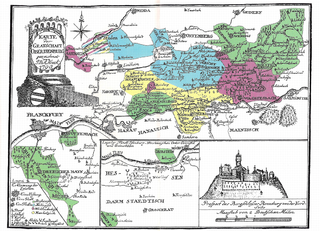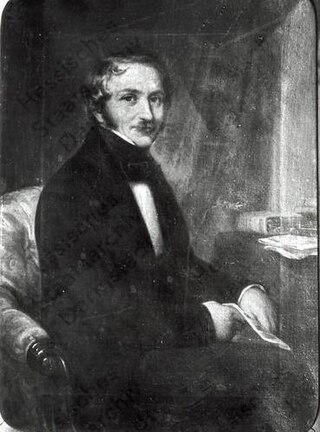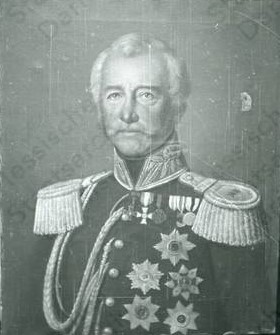Related Research Articles

The County of Isenburg was a region of Germany located in southern present-day Hesse, located in territories north and south of Frankfurt. The states of Isenburg emerged from the Niederlahngau, which partitioned in 1137 into Isenburg-Isenburg and Isenburg-Limburg-Covern. These countships were partitioned between themselves many times over the next 700 years.

Isenburg-Büdingen was a County of southern Hesse, Germany, located in Büdingen. It was originally a part of the County of Isenburg.

Isenburg-Meerholz was a County of southern Hesse, Germany. It was created as a partition of Isenburg-Büdingen in 1687 and was mediatised to Isenburg in 1806. In 2007, with the addition of Romania and Bulgaria, Meerholz became the European Union's new geographical centre.
Isenburg and Büdingen in Birstein is a hereditary title associated with the German House of Isenburg. Prince Alexander of Isenburg is the current Prince of Isenburg and Büdingen in Birstein.

Büdingen is a town in the Wetteraukreis, in Hesse, Germany. It is mainly known for its well-preserved, heavily fortified medieval town wall and half-timbered houses.
Isenburg-Kempenich was the name of a state of the Holy Roman Empire, based around Kempenich in modern Rhineland-Palatinate, Germany.

Ronneburg is both a castle and a municipality in the district of Main-Kinzig, in Hessen, Germany. The town is most notable for being the site of Ronneburg castle.
Isenburg-Neumagen was the name of a state of the Holy Roman Empire, seated in Neumagen-Dhron in modern Rhineland-Palatinate, Germany.
Princess Alexandra of Hannover was a German politician, philanthropist, and wife of Prince Welf Henry of Hanover. Hannover lastly served as a councilwoman representing the Niederrad district of Frankfurt on the Frankfurt City Council. She was a member of the Christian Democratic Union political party.

Waechtersbach ceramics is a German ceramics manufacturer in Brachttal near Wächtersbach, which was founded in 1832 by the Prince Adolf of Ysenburg and Büdingen of Isenburg-Wächtersbach. It is a registered company since 4 July 2003.

Bruno Casimir Albert Emil Ferdinand of Ysenburg and Büdingen was the third Prince of Ysenburg and Büdingen. Bruno was the eldest son of Ernst Casimir II, 2nd Prince of Ysenburg and Büdingen and his wife Countess Thekla of Erbach-Fürstenau.
Salentin VI of Isenburg-Neumagen was the Count of Isenburg-Neumagen from 1502 until 1534.

Adolph II of Isenburg-Wächtersbach was a German aristocrat, as Count of Isenburg-Wächtersbach.
Louis Maximilian I of Isenburg-Wächtersbach was a German count of Isenburg-Wächtersbach from 1798 to 1805. The county itself lasted from 1673 to 1806 in the central Holy Roman Empire, until it was mediated to Isenberg. He was also a descendant of Ferdinand Maximilian I of Isenburg-Wächtersbach.

Julius, Count of Lippe-Biesterfeld was Count of Lippe-Biesterfeld from 1840 to 1884 and father of Ernest II, regent of the Principality of Lippe.

Karl II, Prince of Isenburg-Büdingen in Birstein was head of the mediatised German house of Isenburg and Büdingen.

Ferdinand Maximilian III of Ysenburg-Wächtersbach was the head of the Wächtersbach branch of the House of Ysenburg and the first Prince of Isenburg-Budingen-Wächtersbach.
Christine Eleonore of Stolberg-Gedern. was a German noblewoman of The House of Stolberg and by marriage Countess of Isenburg-Büdingen.
Ernst Dietrich, of Ysenburg-Büdingen was a German Count (Graf) from the House of Isenburg-Büdingen.

Ernst Casimir I, Prince of Ysenburg and Büdingen was a prince of Isenburg-Büdingen, a former County of southern Hesse, Germany.
References
- ↑ Simon, G. Die Geschichte des reichständischen Hauses Ysenburg und Büdingen, etc, Volume 2 [The History of the Imperial House of Ysenburg and Büdingen, etc, Volume 2] (in German). p. 96.
Preceded by: | Henry | Succeeded by: |
|---|---|---|
| Salentin VI | Count of Isenburg-Neumagen 1534–1554 | extinct to Sayn-Homburg |